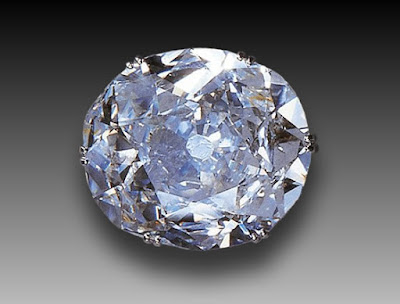 |
| The Koh-i-Noor in its original size and setting |
As with many legendary diamonds and gems, there are contrasting stories and rumors regarding the origin of the Koh-I-Noor. Some believe it was a gift to the earth from Surya (the god of the sun), and that evidence of its existence can be found in ancient Sanskrit writings, dating back over 5000 years. Some Hindus believe it was stolen from the great god Krishna as he lay asleep, whilst others say the Koh-I-Noor was, in fact, the Syamantaka Jewel, another famous precious stone from Indian mythology, believed to have been blessed with great magical powers.
FIRST MENTION OF THE GEM
Malik Kafur, Alauddin Khilji's general, made a successful raid on Warangal in 1310 where he might have acquired the Koh-i-noor diamond.The diamond remained with Khilji dynasty, and later passed on to the succeeding dynasties of the Delhi Sultanate, until it came into the possession of Babur, who established the Mughal Empire in 1526. He called the stone 'the Diamond of Bābur' at the time, although it had been called by other names before it came into his possession. Both Babur and his son and successor, Humayun mention in their memoirs the origins of 'the Diamond of Bābur'.
The emperor Shah Jahan had the diamond mounted on his famous peacock throne.
THE KOH-I-NOOR GETS ITS NAME
Following the invasion of Nadir Shah, the Turkic ruler of Afsharid Persia in 1739 and the sacking of Agra and Delhi. Along with the Peacock Throne, he also carried off the Koh-i-Noor to Persia in 1739. It was allegedly Nādir Shāh who exclaimed "Koh-i-Noor!" ("Mountain of Light!") when he finally managed to obtain the famous stone, and this is how the stone gained its present name. There is no reference to this name before 1739.
After the assassination of Nādir Shāh in 1747, the stone came into the hands of his general, Ahmad Shāh Durrānī, who later became the Emir of Afghanistan. In 1830, Shujāh Shāh Durrānī, the deposed Emir of Afghanistan and a descendant of Ahmad Shah Durrani, managed to flee with the diamond. He went to Lahore where the Sikh Maharaja Ranjit Singh forced him to surrender the stone and took its possession.
 |
| Portrait of Ahmad Shah Durrani, with the Koh-i-Noor on his turban |
THE KOH-I-NOOR FALLS INTO BRITISH HANDS
On 29 March 1849, the British raised their flag on the citadel of Lahore and the Punjab was formally proclaimed part of the British Company rule in India. One of the terms of the Treaty of Lahore, the legal agreement formalising this occupation, was as follows:
"The gem called the Koh-i-Noor which was surrenderd by Shah Shuja-ul-Mulk to Maharajah Ranjit Singh and then surrendered by the Maharajah of Lahore to the Queen of England."
THE DIAMOND IS PRESENTED TO QUEEN VICTORIA
In 1850 the British thought it fitting that the new Maharaja, Duleep Singh, then 13 years old, should personally present the Koh-I-Noor diamond to Queen Victoria, after which it became the centre piece of 'the Great Exhibition' staged in Hyde Park, London, which displayed the large diamond in full public view.
It was decided to re-cut the diamond to improve its brilliance. Prince Albert took a personal interest in having the diamond re-cut. The Koh-i-Noor was badly cut, rose, not brilliant cut. This was probably done during the time of Shah Jahan when it was mounted onto the Peacock Throne. Before that, it was probably even larger in size. Professor Tennant and Reverend W. Mitchell, Lecturer in Mineralogy at King's College, London, were also consulted. Accordingly they wrote a report in which they admitted the improvement which the proposed recutting would have upon the stone, but at the same time they expressed fears that any cutting could endanger its integrity.
The royal jewellers, Garrads were consulted and they recommended Messrs Coster of Amsterdam, who said the gem could be recut without harming it. Prince Albert gave his permission and Coster sent two of his best men to London, who then worked for 38 days to recut the stone. The final result was an oval brilliant weighing 108.93 metric carats, which meant a loss of weight of just under 43 per cent. plus two smaller stones which could be used for pendants. Queen Victoria had it mounted on a tiara with 2,000 diamonds.
 |
| The 109-carat Koh-i.Noor diamond |
THE KOH-I-NOOR TODAY
After Queen Victoria's death it was set in Queen Alexandra's brand-new diamond crown, with which she was crowned at the coronation of her husband, King Edward VII. Queen Alexandra was the first Queen Consort to use the diamond in her crown, followed by Queen Mary and then Queen Elizabeth, the Consort of King George VI.
 | |||||
| The Koh-i-Noor in the Queen Mother's crown |
It remained the crown of Queen Elizabeth the Queen Mother, until her death. The crown is now kept in the Tower of London. It is the third largest diamond in the Crown Jewels collection.
No comments:
Post a Comment